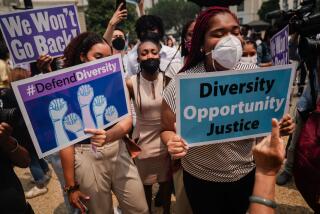The Battle of the Disabled Is Not Over
- Share via
This past Wednesday marked the 10th anniversary of the Americans with Disabilities Act. Many people believe that the ADA was a gift to the disability community; that it was given not to correct an injustice, but out of charity. In fact, the ADA resulted from a long, difficult fight by the disability community.
The disability rights movement has several goals: freedom for people with disabilities to live as they choose; equal opportunity to achieve their dreams; and dignity in society. In 10 years, we have made progress toward those goals. Yet problems remain:
* Freedom--Nondisabled people can go to any business they like. People with disabilities cannot. There are barriers everywhere that limit the freedom of people with disabilities--a physical barrier, communication barrier or attitude barrier. However, the nondisabled rarely notice them.
* Equal opportunity--Schools still segregate students with disabilities and give them a substandard education. As a result, according to a Harris poll, 22% of people with disabilities do not complete high school, compared with 9% of nondisabled people. Employers still reject applicants with disabilities. Only 32% of people with disabilities are employed (compared with 81% of nondisabled people).
* Dignity--People still assert overblown fears of safety risks supposedly posed by people with disabilities, as in the case of a baseball coach barred from the field because he uses a wheelchair, in spite of his accident-free four-year career in coaching.
People still assert negative assumptions about the intelligence and abilities of people with disabilities, as in the college professor who excluded a blind student from his biology class because he decided, before class even started, that she would not do well. Employers still assert fears of costs and absenteeism, even though those fears have been proved to be baseless. As a result, 29% of people with disabilities live in poverty (10% of nondisabled people are poor).
Change takes time. Similar prejudices about intelligence and absenteeism were used to oppress racial minorities and women, and it has taken time to overcome those attitudes. It will also take time for the disability rights movement to overcome discrimination.
However, disability rights are now under serious attack. The U.S. Supreme Court recently restricted the ADA. An employer can now fire someone with an impairment but, at the same time, can avoid liability for discrimination by arguing that the person is not covered by the law because he or she takes medication to control the impairment. The California Supreme Court is deciding whether to apply the same restrictions to California law.
Several states are asking the U.S. Supreme Court to hold the ADA unconstitutional as applied to states. If the court agrees, states will be able to discriminate without penalty. Congress recently considered a bill that would require a person who encounters disability discrimination to write to the business and give it 90 days to fix the violation. If the business agrees to fix the violation, the individual would not be allowed to sue for the past discrimination. If a person of color was told that she could not be served in a restaurant, would we require her to write to the restaurant and give them three months to say they won’t do it again? If the restaurant owners said they wouldn’t do it again, would we deny her compensation for being excluded previously? No. Is disability discrimination any less reprehensible?
The ADA was a beginning. With time, we can achieve the disability rights movement’s goals. The current attacks, however, threaten to take us backward to a society of segregation, fear and dependence.
More to Read
Sign up for Essential California
The most important California stories and recommendations in your inbox every morning.
You may occasionally receive promotional content from the Los Angeles Times.













